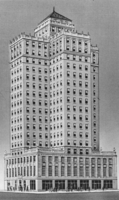
In April 1867, William Dickinson Jr., his sons, and others associated with the Kanawha Valley salt industry founded the Kanawha Valley Bank. In 1869, the group built a two-story bank at the present intersection of Kanawha Boulevard and Capitol Street in downtown Charleston. In 1870, Henry Clay Dickinson was chosen president of Kanawha Valley Bank and also elected mayor of the city. He died in May 1871, to be succeeded by a brother-in-law and then by father William Dickinson, the bank founder. Upon William’s death in 1882, son John Quincy Dickinson became president for the next 43 years.
Of the three banks opened in Charleston immediately after the Civil War, Kanawha Valley Bank was the only one to survive the financial panic of 1873. From initial capitalization of $30,000 the bank grew to more than $600,000 in assets by 1882. In 1893, John Q. Dickinson chose to invest in a substantial new building, five floors on Front Street (now Kanawha Boulevard) with an elaborate stone and brick facade and turret. The move was a statement of confidence to the business community and to the swarm of speculators coming to West Virginia with the boom in timber, coal, and oil and gas.
In 1894, John L. Dickinson became cashier of the bank, a position he retained until he was elevated to the presidency following the death of father John Q. Dickinson in 1925. A month before the stock market crash of 1929, John L. Dickinson moved his bank into new quarters on the former site of the capitol of West Virginia. The 20-story building, the tallest and most prestigious business address in the state for many years, remains a Charleston landmark.
John L. Dickinson was succeeded as president of Kanawha Valley Bank in 1949 by Hayes Picklesimer, who had first come to work at the bank in 1918. In 1967, Hugh Curry became president and set in motion the process that eventually modernized West Virginia banking regulations by legislative action to allow branch banking. He hired Robert F. Baronner from Pennsylvania, whose experience in branch banking was critical. Baronner was in charge of developing a new high rise bank building, One Valley Square, into which the bank moved in 1976. Becoming president in 1975, Baronner oversaw the change to a national bank charter, the establishment of the bank holding company, and the acquisitions and expansions that made the renamed One Valley Bank the largest bank and bank holding company in the state.
In 2000, One Valley Bank was acquired by BB&T Bank Corporation, which in 2019 merged with SunTrust to become Truist Bank.
This Article was written by Bill Drennen
Last Revised on July 20, 2023
Related Articles
Sources
Drennen, Bill. One Kanawha Valley Bank: A History. Charleston: 2001.
Baronner, Robert; Morrison, Holmes; Pauley, Don; Ratrie, Mary Price. Interviews by author. 1997-2000.
Cite This Article
Drennen, Bill "Kanawha Valley Bank." e-WV: The West Virginia Encyclopedia. 20 July 2023. Web. 26 July 2024.


Comments?
So far, this article has 1 comment.
Click here to read and contribute to the discussion →